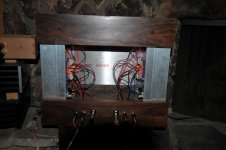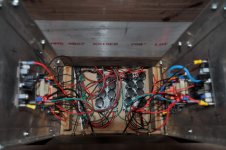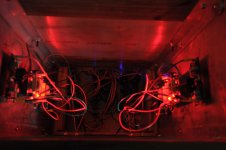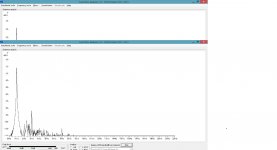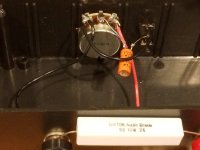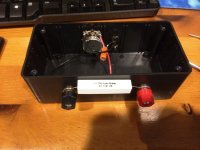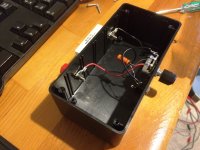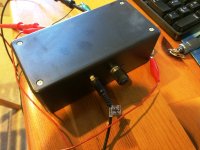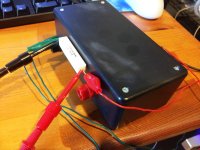One more thing. This amp is extremely heavy. It is easily 70 lbs. Maybe more. It's deceiving. To some the weight can be an issue. Smaller mono blocks can be a solution. Handles might help to lift it. Small feet prevent me from easily placing my fingers under it to get a grip. Larger feet might help. Health problems from lifting heavy things are no joke. Seems like silly advise, until you try to lift it. Get help! 😀
It's no joke. I can't lift anything heavier than an XA60. Desmond used to
leg press 800 lbs, so now he's president of the company.
😎
leg press 800 lbs, so now he's president of the company.
😎
Speaking of lifting - I just finished my Funny^6 ( boards with many thanks to buzzforb). I had to build it in two boxes so I could move it without hiring a moving guy. Nicknamed the beast.
Utilizes SSR100 at 1.25A
To my ears and in my system it has the widest and deepest soundstage I have heard with all the other great attributes that have been mentioned with respect to the F6.
Thanks again buzz
Utilizes SSR100 at 1.25A
To my ears and in my system it has the widest and deepest soundstage I have heard with all the other great attributes that have been mentioned with respect to the F6.
Thanks again buzz

Attachments
Spectrum Analyzer
Hi Guys,
Put together a probe for a FFT spectrum analyzer. Before running it across the F6, tested it against a 50w T-amp. By the looks of the graph, it's dominant third harmonic. The software is free, but seems to have enough resolution to provide a good graph. The name of the software is at the top of the window.
Placed an 8-ohm 10w resistor across the outputs of both channel, although only one channel is tested. Ran a 1khz sine until an AC meter read 2.8v.
I'm guessing from all the years of reading Audio magazine that 2.83v is around 1 watt output.
The bottom graph is 120 A-weighted. Ignore the top graph. It's an editing error.
Once I have time, I'll edit and post pics of the probe in the box.
Vince
Does all this seem about right?
Vince
Hi Guys,
Put together a probe for a FFT spectrum analyzer. Before running it across the F6, tested it against a 50w T-amp. By the looks of the graph, it's dominant third harmonic. The software is free, but seems to have enough resolution to provide a good graph. The name of the software is at the top of the window.
Placed an 8-ohm 10w resistor across the outputs of both channel, although only one channel is tested. Ran a 1khz sine until an AC meter read 2.8v.
I'm guessing from all the years of reading Audio magazine that 2.83v is around 1 watt output.
The bottom graph is 120 A-weighted. Ignore the top graph. It's an editing error.
Once I have time, I'll edit and post pics of the probe in the box.
Vince
Does all this seem about right?
Vince
Attachments
Last edited:
I did not take into account in my deleted answer that you got by email service that the 1kHz signal started at -20dB
So this would be around 0.079433% at one Watt/8R.
Hm, could be lower for k3 dominance…
hope I made the calculation right this time….. 🙂
I just remember that I only build the SS version, if yours is the IRF version the values might be normal.
So this would be around 0.079433% at one Watt/8R.
Hm, could be lower for k3 dominance…
hope I made the calculation right this time….. 🙂
I just remember that I only build the SS version, if yours is the IRF version the values might be normal.
Last edited:
Thanks generg. I'm not so concerned about how the t-amp tests. More concerned about the test setup being correct. Am I getting a good reading?
Since nothing turned to flames, I will test a 5w SIT, Zen9, and gain clone to see if the signature changes.
Thanks
Vince
Since nothing turned to flames, I will test a 5w SIT, Zen9, and gain clone to see if the signature changes.
Thanks
Vince
why don't you change the distortion spectra with the 10R pots over the source resistors?
So you can easily get different kind of sounds….. 🙂
So you can easily get different kind of sounds….. 🙂
So you can easily get different kind of sounds….. 🙂
Hooked up the F6 and played with p3 and 4. Was able to add some 2nd harmonic and add/remove 3rd, but not able to reduce 2nd all that much.
Took snapshot of one channel and matched to the other channel. Added a bit of 2nd and reduced 3rd a little to see what the result would be and found the sound to be softer. Definitely less presence.
That is my experience too,
I like mostly k2 10dB higher than k3, but this may also depend.....using SS or IRF.
So F6 can really sound very different.
Normally you can't reduce k3 completely and as far as I understand some or even most k3 comes from the Jensen, so turning the pots will not change much.
Getting the k2 to zero demands two identical SS, nearly impossible.....only working in Spice......🙂
I like mostly k2 10dB higher than k3, but this may also depend.....using SS or IRF.
So F6 can really sound very different.
Normally you can't reduce k3 completely and as far as I understand some or even most k3 comes from the Jensen, so turning the pots will not change much.
Getting the k2 to zero demands two identical SS, nearly impossible.....only working in Spice......🙂
Here's some pics of the probe in a box. Might help someone get an analyzer going.
The pot is 1M ohm. The cap is electrolytic 2.2uF, but a 1uF was recommended.
I didn't have a problem. The input is the speaker binding posts and the output is the 1/8" connector. The negative side of the cap connects to the right channel "ring" of the 1/8" connector.
Can also use 100k and 10uF cap. Radio Shack has a 1M pot with a 3" shaft.
I cut off 2" by placing the shaft in a vise and firmly holding the pot itself.
The pot is 1M ohm. The cap is electrolytic 2.2uF, but a 1uF was recommended.
I didn't have a problem. The input is the speaker binding posts and the output is the 1/8" connector. The negative side of the cap connects to the right channel "ring" of the 1/8" connector.
Can also use 100k and 10uF cap. Radio Shack has a 1M pot with a 3" shaft.
I cut off 2" by placing the shaft in a vise and firmly holding the pot itself.
Attachments
Just finished adjusting for slight bit (almost equal parts) more k3. Tried to lower both k2 and k3 over all. Less soft, but not harsh. The adjustment are as clear as night and day. Genius.
Used the simpler analyzer again. Visual Analyser is packed with features, but a bit tougher for me to get a view I liked. Maybe learn more about it further on.
Used the simpler analyzer again. Visual Analyser is packed with features, but a bit tougher for me to get a view I liked. Maybe learn more about it further on.
Our good friend Srajan has weighed in on the F6 Jfet vs Mosfet:
6moons audio reviews: FirstWatt F6 production version
😎
6moons audio reviews: FirstWatt F6 production version
😎
Interesting review. As a DIYer, I won't lose any sleep. My F6 has pots, Man!!
It's good to know that until another (reasonable) power jfet replacement for R100 is available, another great amp can be had, with little fussing around, with very readily available parts.
It must be hard keeping everybody happy. 😉
Congratulation!
Vince
It's good to know that until another (reasonable) power jfet replacement for R100 is available, another great amp can be had, with little fussing around, with very readily available parts.
It must be hard keeping everybody happy. 😉
Congratulation!
Vince
Zchweet Mod, any thoughts on pumpin susy into the Jensens ?
As in F6x, with double everything (MOSFET, not power JFET, as me cheapest DIY scheet in known history)
As in F6x, with double everything (MOSFET, not power JFET, as me cheapest DIY scheet in known history)
aren't we already babbled about that - in this one , same as in few buzz's funny threads ?
I believe some of sim pics are here (in my blog before the blog ) :
Babelfish F6 and F6 Bal iterations - diyAudio.rs
I believe some of sim pics are here (in my blog before the blog ) :
Babelfish F6 and F6 Bal iterations - diyAudio.rs
- Home
- Amplifiers
- Pass Labs
- F6 Amplifier
